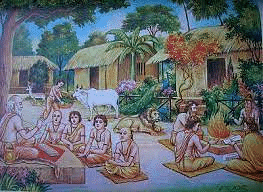Summary: Ancient Education System of India | English Class 8 PDF Download
Introduction
India has fascinated foreigners and travelers throughout history, being a land of wonders. The Indian culture has always encouraged humanity.

Salient Features of Ancient Education System
It emphasized holistic development, focusing on truth, humility, and respect for all creations. Encompassing all aspects of life, it was complementary to life itself.
Sources of Education
Derived from Vedas, Brahmanas, Upanishads, and Dharmasutras, notable ancient scholars like Aryabhata, Panini, and Katyayana contributed. The distinction between Shastras and Kavyas was clear.
- Subjects included History, Logic, Interpretation, Architecture, Polity, etc.
- Universities organized games, and modern-day peer collaboration was present.
Teachers and pupils worked closely, and debates were organized to test knowledge.

Ancient Education System in India – A Way of Life
India had both formal and informal education systems. Temples were involved in imparting quality ancient education, and higher studies took place in viharas and universities, known as Gurukuls.
- The main purpose was to lead a well-defined and disciplined life.
- Living together of gurus and shishyas strengthened their relationship.
- Studies enriched both inner and outer personalities.

- Monks and nuns meditated in monasteries/viharas, attracting learners from various regions.
Viharas and Universities
According to Jataka tales by Xuan Zang and I-Qing, kings showed a special interest in education. Famous universities like Nalanda and Vikramshila, owed their existence to royal contributions.
- Centers of learning catered to higher education needs, fostering knowledge through discussions.

- Occasions resembled modern-day conferences with scholars from different universities or viharas participating.
Takshashila or Taxila
A noted center of learning, including Buddhism, destroyed in the 5th century CE. Known for higher education, Panini, a notable alumnus, authored Ashtadhyayi, a famous grammar work. Despite arduous journeys, students visited this UNESCO World Heritage Site from remote places.
Nalanda University
Role of Community
Education was free, supported by donations from rich merchants. In South India, agraharas were education centers. Ghatika, a small-size center, was also present, emphasizing learning religion.
Continuation of Indian Education System

|
36 videos|330 docs|56 tests
|
FAQs on Summary: Ancient Education System of India - English Class 8
| 1. What were the salient features of the ancient education system in India? |  |
| 2. How was the ancient education system in India considered a way of life? |  |
| 3. What were Viharas and Universities in the ancient education system of India? |  |
| 4. What was the role of the community in the ancient education system of India? |  |
| 5. Did the Indian education system continue to evolve after ancient times? |  |





















